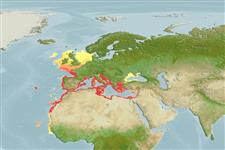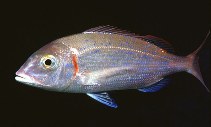Pagellus erythrinus (Linnaeus, 1758)
Common pandora
Add your observation in Fish Watcher
| Native range | All suitable habitat | Point map | Year 2050 |

|
| This map was computer-generated and has not yet been reviewed. |
| Pagellus erythrinus AquaMaps Data sources: GBIF OBIS |
Upload your photos and videos
Pictures | Google imagePagellus erythrinus
Picture by Hernández-González, C.L.
Pictures | Google imagePagellus erythrinus
Picture by Hernández-González, C.L.
Libya country information
Common names:
Morjan, ﻥﺎﺟﺮﻣ
Occurrence: native
Salinity: marine
Abundance: | Ref:
Importance: | Ref:
Aquaculture: | Ref:
Regulations: | Ref:
Uses: no uses
Comments:
National Checklist:
Country Information: https://www.cia.gov/library/publications/resources/the-world-factbook/geos/ly.html
National Fisheries Authority:
Occurrences: Occurrences Point map
Main Ref: Bauchot, M.-L., 1987
National Database:
Occurrence: native
Salinity: marine
Abundance: | Ref:
Importance: | Ref:
Aquaculture: | Ref:
Regulations: | Ref:
Uses: no uses
Comments:
National Checklist:
Country Information: https://www.cia.gov/library/publications/resources/the-world-factbook/geos/ly.html
National Fisheries Authority:
Occurrences: Occurrences Point map
Main Ref: Bauchot, M.-L., 1987
National Database:
Common names from other countries
Classification / Names Nombres comunes | Sinónimos | Catalog of Fishes(Género, Especie) | ITIS | CoL | WoRMS | Cloffa
> Eupercaria/misc (Various families in series Eupercaria) > Sparidae (Porgies)
Etymology: Pagellus: Diminutive of Latin, pager, derived from Greek, pagros = a fish, Dentex sp. (Ref. 45335).
More on author: Linnaeus.
Etymology: Pagellus: Diminutive of Latin, pager, derived from Greek, pagros = a fish, Dentex sp. (Ref. 45335).
More on author: Linnaeus.
Environment: milieu / climate zone / depth range / distribution range Ecología
marino bentopelágico; rango de profundidad ? - 300 m (Ref. 4781), usually 20 - 100 m (Ref. 4781). Subtropical; 63°N - 10°N, 32°W - 42°E
Distribución Países | Áreas FAO | Ecosistemas | Ocurrencias, apariciones | Point map | Introducciones | Faunafri
Eastern Atlantic: Norway and the Mediterranean to Guinea-Bissau (Ref. 26999), including Cape Verde, Madeira and the Canary Islands. Rarely recorded in Scandinavia (Ref. 4781).
Length at first maturity / Tamaño / Peso / Age
Maturity: Lm 14.2, range 13 - 16 cm
Max length : 60.0 cm SL macho / no sexado; (Ref. 4781); common length : 25.0 cm SL macho / no sexado; (Ref. 4781); peso máximo publicado: 3.2 kg (Ref. 40637)
Max length : 60.0 cm SL macho / no sexado; (Ref. 4781); common length : 25.0 cm SL macho / no sexado; (Ref. 4781); peso máximo publicado: 3.2 kg (Ref. 40637)
Short description Claves de identificación | Morfología | Morfometría
Espinas dorsales (total) : 12; Radios blandos dorsales (total) : 10 - 11; Espinas anales: 3; Radios blandos anales: 8 - 9. Body red without stripes or bars. Snout at least twice as long as the eye diameter (Ref. 35388).
Found on inshore waters, on various bottom (rock, gravel, sand and mud) to 200 m (Mediterranean) or 300 m (Atlantic) and move to deeper waters during winter. Omnivorous, but feed mainly on benthic invertebrates and small fishes (Ref. 3688). Protogynic hermaphrodites, females become males first in their third year with sizes of about 17 cm. Important food fish.
Life cycle and mating behavior Madurez | Reproducción | Puesta | Huevos | Fecundidad | Larva
Possibly two spawning periods in the southern Mediterranean (Ref. 4781). Length at which sex change possibly occurs is between 12.8 and 20.3 cm FL (Ref. 57849).
Main reference
Upload your references | Referencias | Coordinador | Colaboradores
Bauchot, M.-L. and J.-C. Hureau, 1990. Sparidae. p. 790-812. In J.C. Quero, J.C. Hureau, C. Karrer, A. Post and L. Saldanha (eds.) Check-list of the fishes of the eastern tropical Atlantic (CLOFETA). JNICT, Lisbon; SEI, Paris; and UNESCO, Paris. Vol. 2. (Ref. 3688)
IUCN Red List Status (Ref. 130435: Version 2024-2)
Least Concern (LC) ; Date assessed: 17 August 2009
Human uses
Pesquerías: comercial; pesca deportiva: si
FAO(Aquaculture systems: producción; pesquerías: producción; publication : search) | FishSource | Sea Around Us
Más información
Trophic ecology
componentes alimenticios
Composición de la dieta
consumo de alimento
Food rations
Despredadores
componentes alimenticios
Composición de la dieta
consumo de alimento
Food rations
Despredadores
Population dynamics
Coeficiente del crecimiento para
Max. ages / sizes
Length-weight rel.
Length-length rel.
Length-frequencies
Mass conversion
Reclutamiento
Abundancia
Coeficiente del crecimiento para
Max. ages / sizes
Length-weight rel.
Length-length rel.
Length-frequencies
Mass conversion
Reclutamiento
Abundancia
Life cycle
Reproducción
Madurez
Fecundidad
Puesta
Spawning aggregations
Huevos
Egg development
Larva
Dinámica larvaria
Reproducción
Madurez
Fecundidad
Puesta
Spawning aggregations
Huevos
Egg development
Larva
Dinámica larvaria
Physiology
Body composition
Nutrients
Consumo del oxígeno
Tipo de natación
Velocidad de natación
Visual pigments
Fish sound
Diseases & Parasites
Toxicity (LC50s)
Body composition
Nutrients
Consumo del oxígeno
Tipo de natación
Velocidad de natación
Visual pigments
Fish sound
Diseases & Parasites
Toxicity (LC50s)
Human related
Aquaculture systems
Perfiles de acuicultura
Razas
Ciguatera cases
Stamps, coins, misc.
Aquaculture systems
Perfiles de acuicultura
Razas
Ciguatera cases
Stamps, coins, misc.
Herramientas
Bio-Quiz | E-book | Guía de campo | Claves de identificación | Asistente para frecuencias de tallas | Herramienta de ciclo de vida | Mapa de puntos | Classification Tree
| Catch-MSY |
Special reports
Download XML
Fuentes de Internet
Aquatic Commons | BHL | Cloffa | Websites from users | Check FishWatcher | CISTI | Catalog of Fishes(Género, Especie) | DiscoverLife | DORIS | ECOTOX | Faunafri | Fishtrace | GenBank(genome, nucleotide) | GloBI | GOBASE | | Google Books | Google Scholar | Google | IGFA World Record | MitoFish | Bases de datos nacionales | Otolith Atlas of Taiwan Fishes | Acuarios públicos | PubMed | Reef Life Survey | Scirus | SeaLifeBase | Árbol de la vida | Wikipedia(Go, búsqueda) | World Records Freshwater Fishing | Expediente Zoológico
Estimates based on models
Preferred temperature (Ref. 115969): 12.2 - 21, mean 17.2 (based on 492 cells).
Phylogenetic diversity index (Ref. 82804): PD50 = 0.5156 [Uniqueness, from 0.5 = low to 2.0 = high].
Bayesian length-weight: a=0.01000 (0.00902 - 0.01109), b=3.02 (3.00 - 3.04), in cm Total Length, based on LWR estimates for this species (Ref. 93245).
Nivel trófico (Ref. 69278): 3.5 ±0.1 se; based on diet studies.
Resiliencia (Ref. 120179): Medio, población duplicada en un tiempo mínimo de 1.4-4.4 años (K=0.24; tm=1-2; tmax=13; Fec=31,000).
Prior r = 0.54, 95% CL = 0.35 - 0.80, Based on 8 full stock assessments.
Fishing Vulnerability (Ref. 59153): Moderate vulnerability (40 of 100).
Climate Vulnerability (Ref. 125649): Moderate vulnerability (41 of 100).




